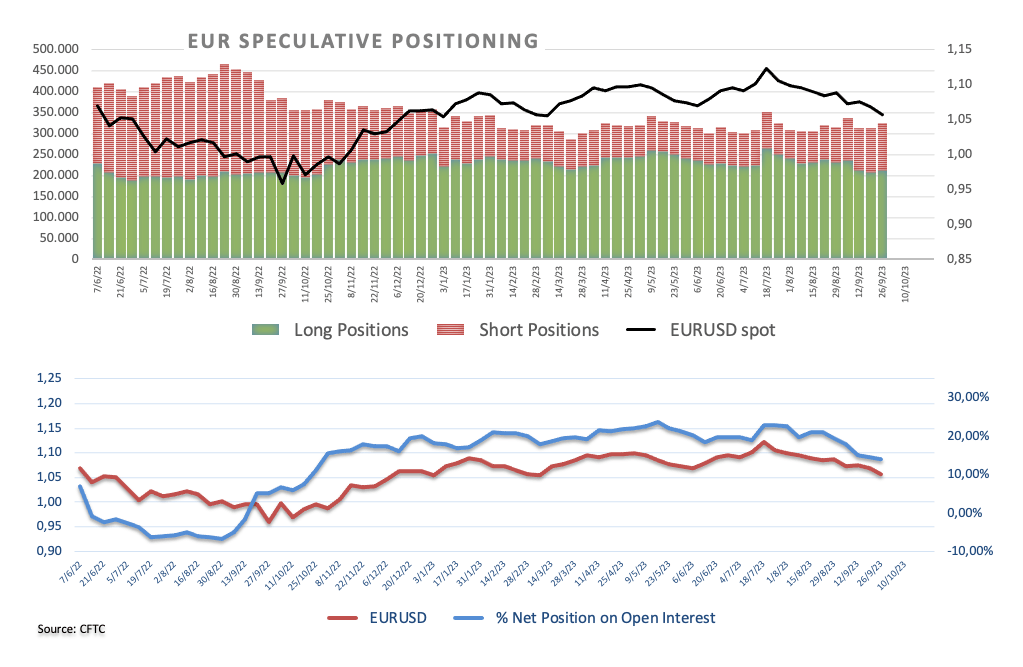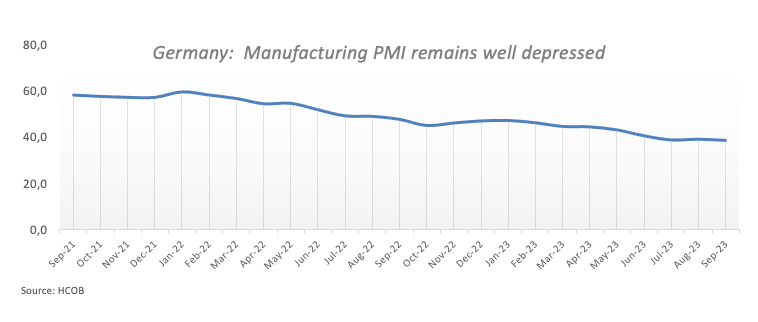Euro loses the grip and approaches 1.0500, looks at US ISM
- The Euro keeps the negative tone unchanged vs. the US Dollar.
- Stocks in Europe trade mostly on the defensive on Monday.
- EUR/USD's recovery falters ahead of the 1.0600 hurdle so far.
- The USD Index (DXY) looks firmer and revisits the 106.60 zone.
- No surprises from final Manufacturing PMIs in the euro area.
- The ISM Manufacturing PMI takes centre stage across the pond.

The Euro (EUR) reverses the initial optimism against the US Dollar (USD) on Monday, prompting sellers to return to the market and drag the EUR/USD to the area of so far daily lows around 1.0520 at the beginning of the week.
Meanwhile, the Greenback appears to have regained composure and lifts the USD Index (DXY) back to the 106.50 region amidst the broad-based sour sentiment in the risk-linked complex, while a small uptick in US yields across different timeframes also contributes to the upbeat mood in the Dollar.
Still around the bonds market, the German 10-year bund yields follow their American peers and advance to the vicinity of 2.90%, partially reversing Friday's knee-jerk.
The monetary policy forecast remains unaltered, with investors expecting the Federal Reserve (Fed) to raise interest rates by 25 bps before the end of the year. Meanwhile, market talks about a probable stalemate in policy changes at the European Central Bank (ECB) continue, despite inflation levels that surpass the bank's objective and rising fears about a potential recession.
On the positioning front, EUR net longs extended the decline during the week ended on September 26, according to CFTC’s report, falling in line with the sharp sell-off observed in spot in the last few weeks. Net long retreatead to levels last seen in late October 2022 around 98300 contracts.
In the domestic docket, the final Manufacturing PMI in Germany came in at 39.6 in September and 43.4 when it comes to the broader eurozone. In addition, the bloc's Unemployment Rate held steady at 6.4% in August.
In the US, all the attention is expected to be on the release of the ISM Manufacturing PMI, seconded by Construction Spending, the final S&P Global Manufacturing PMI, and speeches by Federal Reserve Bank of Philadelphia President Patrick Harker (voter, hawk), FOMC Governor Michael Barr (permanent voter, centrist), and Federal Reserve Bank of New York President John Williams (permanent voter, centrist).
Daily digest market movers: Euro opens the door to further losses
- The EUR loses further momentum against the USD.
- US and German yields trade with decent gains on Monday.
- Markets factor in an extra rate hike by the Fed before year-end.
- Investors foresee an impasse at the ECB’s tightening campaign.
- Chinese PMIs came in mixed for September.
- FX intervention fears remain well and sound around USD/JPY.
Technical Analysis: The YTD low at 1.0481 comes next
EUR/USD looks to consolidate the rebound from last week’s lows around 1.0490.
If the EUR/USD rebound gets more serious, the pair should encounter the next up-barrier at the September 12 high of 1.0767, before reaching the crucial 200-day Simple Moving Average (SMA) at 1.0827. If the pair breaks beyond this level, it may set up a challenge of the transitory 55-day SMA at 1.0843, ahead of the August 30 top at 1.0945 and the psychological barrier of 1.1000. The surpass of the latter might prompt the pair to test the August 10 peak of 1.1064 ahead of the July 27 high of 1.1149 and the 2023 top of 1.1275 seen on July 18.
On the downside, the September 28 low of 1.0491 emerges as the next support prior to the 2023 low of 1.0481 from January 6.
As long as the EUR/USD remains below the 200-day SMA, the possibility of more negative pressure exists.
Euro FAQs
What is the Euro?
The Euro is the currency for the 20 European Union countries that belong to the Eurozone. It is the second most heavily traded currency in the world behind the US Dollar. In 2022, it accounted for 31% of all foreign exchange transactions, with an average daily turnover of over $2.2 trillion a day.
EUR/USD is the most heavily traded currency pair in the world, accounting for an estimated 30% off all transactions, followed by EUR/JPY (4%), EUR/GBP (3%) and EUR/AUD (2%).
What is the ECB and how does it impact the Euro?
The European Central Bank (ECB) in Frankfurt, Germany, is the reserve bank for the Eurozone. The ECB sets interest rates and manages monetary policy.
The ECB’s primary mandate is to maintain price stability, which means either controlling inflation or stimulating growth. Its primary tool is the raising or lowering of interest rates. Relatively high interest rates – or the expectation of higher rates – will usually benefit the Euro and vice versa.
The ECB Governing Council makes monetary policy decisions at meetings held eight times a year. Decisions are made by heads of the Eurozone national banks and six permanent members, including the President of the ECB, Christine Lagarde.
How does inflation data impact the value of the Euro?
Eurozone inflation data, measured by the Harmonized Index of Consumer Prices (HICP), is an important econometric for the Euro. If inflation rises more than expected, especially if above the ECB’s 2% target, it obliges the ECB to raise interest rates to bring it back under control.
Relatively high interest rates compared to its counterparts will usually benefit the Euro, as it makes the region more attractive as a place for global investors to park their money.
How does economic data influence the value of the Euro?
Data releases gauge the health of the economy and can impact on the Euro. Indicators such as GDP, Manufacturing and Services PMIs, employment, and consumer sentiment surveys can all influence the direction of the single currency.
A strong economy is good for the Euro. Not only does it attract more foreign investment but it may encourage the ECB to put up interest rates, which will directly strengthen the Euro. Otherwise, if economic data is weak, the Euro is likely to fall.
Economic data for the four largest economies in the euro area (Germany, France, Italy and Spain) are especially significant, as they account for 75% of the Eurozone’s economy.
How does the Trade Balance impact the Euro?
Another significant data release for the Euro is the Trade Balance. This indicator measures the difference between what a country earns from its exports and what it spends on imports over a given period.
If a country produces highly sought after exports then its currency will gain in value purely from the extra demand created from foreign buyers seeking to purchase these goods. Therefore, a positive net Trade Balance strengthens a currency and vice versa for a negative balance.
Author

Pablo Piovano
FXStreet
Born and bred in Argentina, Pablo has been carrying on with his passion for FX markets and trading since his first college years.



















